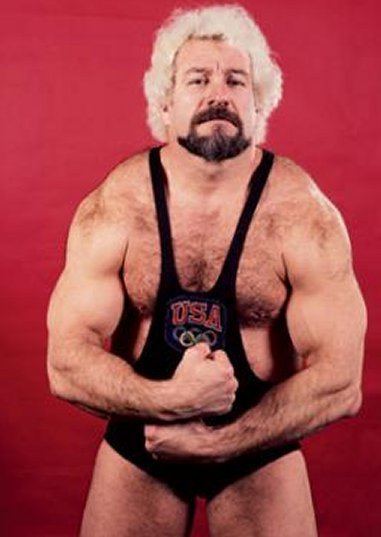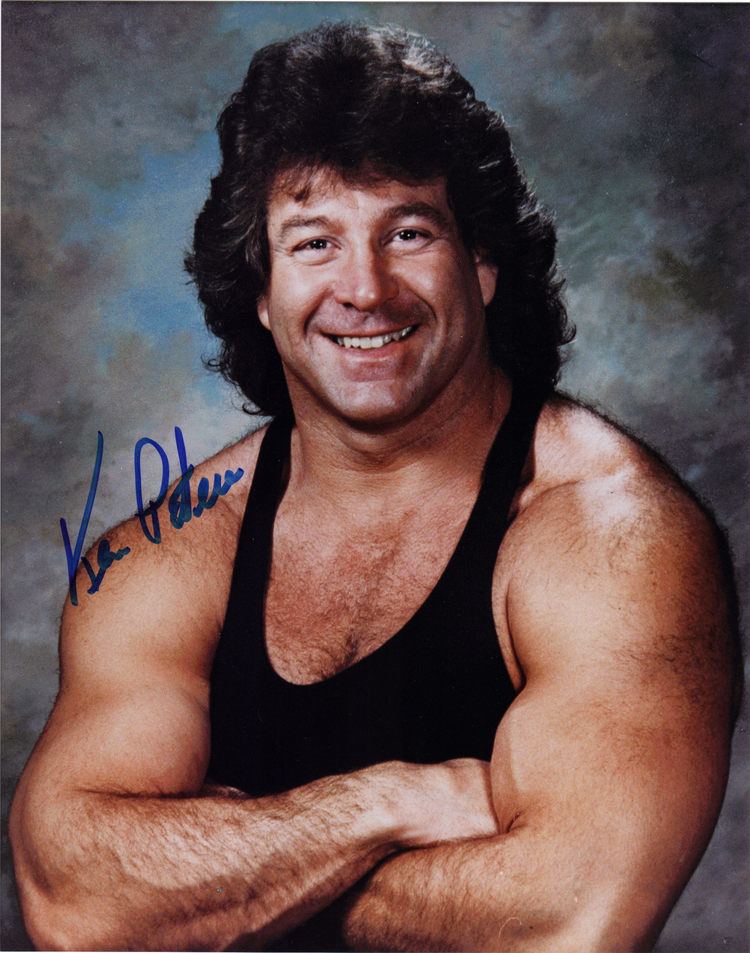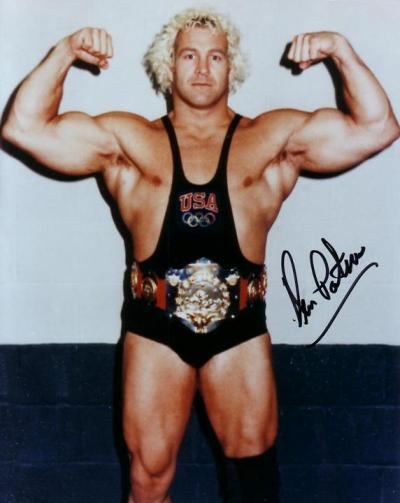Full Name Kenneth Patera Weight 116 kg Name Ken Patera | Role Professional wrestler Trained by Verne Gagne Height 1.87 m Siblings Jack Patera | |
Occupation Olympic weightlifting, professional wrestling, strongman Similar People Don Muraco, Bobby Heenan, Superstar Billy Graham, Nick Bockwinkel, Lou Albano | ||
Ken patera wwwf wrestling 1977
Kenneth Wayne Patera (born November 6, 1943) is an American retired professional wrestler, Olympic weightlifter, and strongman competitor from the United States.
Contents
- Ken patera wwwf wrestling 1977
- Mean gene okerlund interviews don muraco and ken patera wrestling challenge april 21 1985
- Early athletic career
- Weightlifting career
- Personal records
- Strongman career
- Professional wrestling career
- Personal life
- In wrestling
- Championships and accomplishments
- References

Mean gene okerlund interviews don muraco and ken patera wrestling challenge april 21 1985
Early athletic career

Ken Patera, from a Czech-American family, was strong and extraordinarily athletic, with many people in his family also successful in athletics. His brother Jack Patera played football for the Baltimore Colts and was the head coach for the Seattle Seahawks from 1976 until 1982. His brother Dennis Patera played for the San Francisco 49ers. Ken played football at Cleveland High School in Portland, Oregon, and wrestled weighing at 193 pounds. However, track and field was his first love and he competed in the high hurdles and high jump, but a serious ankle injury forced him to switch to the shot put and discus in high school. Ken grew to become one of the nation's premier track and field weight throwers, competing at Brigham Young University. After his disappointing sixth place finish in the shot-put at the 1968 Olympic trials, he turned his full and complete attention towards Olympic weightlifting.
Weightlifting career

Before becoming a professional wrestler, Patera was a highly decorated Olympic weightlifter. He won several medals at the 1971 Pan American Games (including gold in the weightlifting total), and finished second in the 1971 World Weightlifting Championships just behind Vasily Alekseyev. On his native soil, Patera won four consecutive U.S. Weightlifting Championships in the super heavyweight class from 1969 to 1972. He was the first American to clean and jerk over 500 lbs (227 kg), which he accomplished at the 1972 Senior Nationals in Detroit. He is also the only American to clean and press 500 lbs (227 kg), and was the last American super heavyweight for years to excel at weightlifting at an international level. At the 1972 Summer Olympics in Munich, Germany, Patera was expected to be a serious competitor to Vasily Alekseyev, but he failed to total and was not among the medal recipients. Vasily Alekseyev even stated to the media that Patera was even stronger than him, illustrated by a 550-pound overhead push press (off the racks) that Patera had allegedly done in practice. Nevertheless, when it came to competing, Alekseyev was always the winner. After the clean and press (a lift in which Patera was disproportionately talented) was eliminated from competition, Patera retired from weightlifting.
Personal records

official records – all achieved at a meet in San Francisco on July 23, 1972
→ the highest three-lift total ever made by an American
When measured for the 1972 Olympics, he weighed 321.4 lb (145.8 kg) at a height of 6 ft 1.75 in (1.8733 m).
Strongman career
Patera also competed in the inaugural World's Strongest Man contest in 1977, finishing third behind Bruce Wilhelm and Bob Young.
Being a legitimate weightlifter and strongman, Patera also performed feats of strength during his wrestling career. On an episode of Mid-Atlantic Championship Wrestling, in 1978, Patera and Tony Atlas performed various feats of strength, including driving nails through boards, blowing up a hot water bottle until it popped, bending spikes wrapped in a towel and bending bars over their necks.
Professional wrestling career
Patera became a "strongman" in professional wrestling in 1973, following his weightlifting career. After a stint in the AWA, his first major feud was in the Mid-Atlantic territory against then United States Heavyweight Champion Johnny Valentine, with Patera as the babyface.
The Patera-Valentine house show runs were set up by a TV angle in which Valentine would draw a name out of a fishbowl every week, and the next week wrestle the man whose name he drew. For the first few weeks, Valentine drew the names of one jobber after another, all the time voicing his opposition to wrestling Patera. Finally, Valentine drew a name – and it was Patera's. Patera then appeared on screen and revealed that he had replaced every slip of paper with one that said "Ken Patera".
The next week, the two men met in a 10-minute time limit match on TV, with Patera putting Valentine under with a headlock/chinlock when the bell rang to signify the time limit had expired. Officially, the match ended in a draw, but with Patera on the verge of defeating Valentine (who had been portrayed as nearly unbeatable) on television. The two were matched in a series of house show main events, with Valentine always coming out on top and retaining the U.S. championship.
Patera wrestled mainly as a heel for the World Wrestling Federation (WWF), National Wrestling Alliance (NWA), and American Wrestling Association (AWA) during the 1970s and 1980s. In 1977, he challenged Bruno Sammartino for the WWWF Heavyweight Championship. This was a huge draw around the northeastern part of the United States and at Madison Square Garden, and was one of Sammartino's last great challengers before losing the title to Superstar Billy Graham, which ended his second, shorter WWF title reign. When Bob Backlund later won the title, Patera also unsuccessfully challenged him.
At the height of his career, in 1980, he simultaneously held the WWF's Intercontinental Heavyweight Championship, and the NWA Missouri Heavyweight Championship, two very prestigious titles of that era. He was one of the most hated heels in wrestling (winning Pro Wrestling Illustrated's Most Hated Wrestler Award in 1977), and often used his swinging full nelson to "injure" babyface opponents during matches (most notably Billy White Wolf in August 1977).
Patera returned to the Mid-Atlantic territory as a heel, defeating area legend Chief Wahoo McDaniel for the Mid-Atlantic Heavyweight Championship in April 1978. Patera held that title, off and on, for over a year, losing it to, and regaining it from, Tony Atlas. Patera then lost the title to fellow AWA alumnus Jim Brunzell, in Richmond, Virginia.
Patera was an integral part of the Heenan Family in the AWA (1982–1983), and later in the WWF (1984–1985). While in the AWA, he feuded with Hulk Hogan, Greg Gagne and Jim Brunzell. During Heenan's absence in 1983, caused by a back injury, Patera joined forces with manager Sheik Adnan El-Kaissie and formed a tag team with Jerry Blackwell known as "the Sheiks" (with Patera calling himself "Sheik Lawrence of Arabia"); both men wore Arabian-style garments and feuded with the High Flyers (Greg Gagne and Jim Brunzell) over the AWA World Tag Team Championship, winning the belts in June 1983. Patera and Blackwell later lost the titles to Baron von Raschke and the Crusher. In the WWF, Patera resumed his feud with Hogan, and also assisted Big John Studd in his feud with André the Giant, helping Studd cut Andre's hair after both had attacked him.
The WWF brought Patera back to the company in the spring of 1987 after he had spent the previous year in prison (see below), airing vignettes on WWF TV and releasing a Coliseum Video cassette entitled The Ken Patera Story, which chronicled his career and his return. He was in top physical condition at this point, and his appearance had changed, as he wore natural brown hair, rather than his previous bleached blonde look. On the Right After Wrestling program on Sirius Satellite Radio Channel 98, Patera told hosts Arda Ocal and Jimmy Korderas that his natural hair color was brown and he had decided to wrestle in his natural hair color later in his career. To ensure he would be accepted as a babyface, he claimed that former manager Bobby Heenan had abandoned him and "sold him down the river" while he was in prison. Patera and Heenan held a debate to air their differences, which turned into a physical confrontation between the two that culminated in Patera swinging Heenan with a belt around his neck, causing Heenan to appear on television with a neck brace for months. Patera then began feuding with the Heenan Family (at the time composed of Paul Orndorff, Harley Race, King Kong Bundy and Hercules). In his first match back at Madison Square Garden, the final match of the night, he defeated the Honky Tonk Man via submission with a bearhug, to a huge ovation.
Shortly after his return, Patera ruptured the bicep tendon in his right arm, which led him to miss some time and re-emerge afterward with a stiff and bulky full-length brace for protection. Within six months, Patera was being defeated by newer, younger talent and found himself floundering in a mid-card tag team with fellow Oregonian Billy Jack Haynes. The pair would later feud with Demolition after a televised match where Demolition left Haynes, Patera, and Brady Boone (who played Haynes' cousin) beaten and lying in the ring. In his final televised WWF matches in late 1988 (losses to Bad News Brown, Dino Bravo, "Outlaw" Ron Bass, and "Red Rooster" Terry Taylor), commentators Gorilla Monsoon and Lord Alfred Hayes remarked on-air that Patera's skills were in decline and that he should consider retirement.
Patera returned to the AWA in early 1989 and unsuccessfully challenged the new AWA world champion Larry Zbyszko for the title. He then teamed with Brad Rheingans as "the Olympians." The team defeated Badd Company for the AWA World Tag Team Championship shortly thereafter, but their reign was brief. Fellow weightlifter-turned-wrestler Wayne Bloom challenged Patera to a "car-lifting challenge" in order to get a title shot for him and his partner, Mike Enos. When it was Patera's turn to lift, Enos and manager Johnny Valiant attacked and (kayfabe) injured Patera and Rheingans. This led to the AWA stripping Patera and Rheingans of the title. Rheingans left wrestling for several months in order to have a legitimate knee operation. Patera continued to feud with Bloom and Enos until he left the AWA. Upon his return to the AWA in early 1990, Rheingans resumed the feud until the AWA's demise.
Patera went on to wrestle for Herb Abrams' UWF, as well as PWA and on independent cards primarily in the Minnesota area well into the 1990s, sometimes even promoting his own events.
On August 12, 2011, Patera made a special in-ring appearance at Juggalo Championship Wrestling's "Legends & Icons" event, facing Bob Backlund in a losing effort.
Personal life
Patera is the younger brother of Jack Patera, who coached the NFL's Seattle Seahawks from 1976 to 1982. He is also the brother of former San Francisco 49ers player Dennis Patera.
He has been married (and divorced) three times and has two daughters.
On April 6, 1984, Patera and fellow AWA heel Masa Saito were denied service after hours at a McDonald's restaurant in Waukesha, Wisconsin, prompting an angry Patera to throw a rock through a window of the building (Patera claims that a former employee threw the rock but he received the blame). He and Saito assaulted the policemen sent to arrest them later at a hotel. Sixteen months later, at which point Patera was in the WWF, he was sentenced to two years in prison.
In July 2016, Patera was named part of a class action lawsuit filed against WWE which alleged that wrestlers incurred traumatic brain injuries during their tenure and that the company concealed the risks of injury. The suit is litigated by attorney Konstantine Kyros, who has been involved in a number of other lawsuits against WWE.
